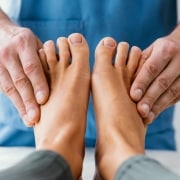How Are Bunions Formed?
HBunions are uncomfortable bumps that most often form on the sides of the feet near the base of the big toe, on the metatarsophalangeal (MTP) joint. They typically grow larger over time, so if you notice a bump developing, you should contact your podiatrist in Austin, TX, for treatment. Note that one form of bunion, called “bunionettes,” forms not on the side of the big toe but on the side of the pinky toe.
The Problem of Bunions
These bumps aren’t just unsightly. They can be extremely painful. They also affect the gait or the foot mechanics when walking, standing or running. But one of the most inconvenient aspects of having bunions is that they make it very difficult to find footwear that fits. This can be a vicious circle because if shoes are too tight because of the bunions, that can make the bunion even worse. Bunions often cause the affected toe to lift up over the abutting toe, creating an unnatural hump that also complicates finding shoes that fit correctly.
What Causes Bunions?
Although there is a form of bunions that is congenital, most bunions are formed from inordinate pressure on that area of the foot. This pressure is most common in shoes that are too tight, or that push the toe into an unnatural position. The main culprits when it comes to bunion-causing shoes are high heels. High heels not only squeeze the toes together; they also lift the back of the foot, so the weight of the body is pushed forward onto the balls of the feet.
How Are Bunions Formed?
Bunions are formed when unnatural bone growth occurs in the area with the extra pressure. This bone growth creates a bump that is often red and inflamed. Essentially, it creates a foot deformity. The first stage in the formation of a bunion happens when the extra pressure causes the bone to be pushed out of place. This forces the joint at the base of your big toe to stick out. Bunions are made of a combination of bone and tissue.
Bunion treatment in Austin, TX, and Pflugerville, TX is available at the podiatrist’s office of Jeffrey LaMour. Contact us for an assessment and to learn about treatment options.





